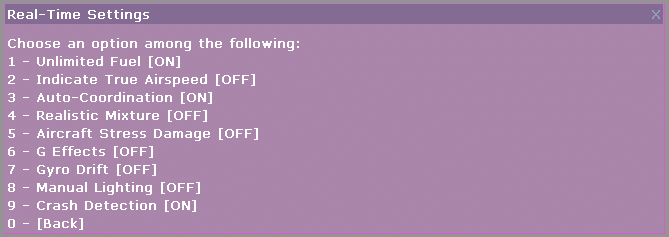Real-Time Settings
This feature gives you direct access to Flight Simulator
settings that are only accessible through the menus and dialogs of
FS2004. Imagine you are flying and want to change the spot distance or
the crash detection. You can do this by clicking the view menu to get
access to the view dialog and change the spot distance as desired, or
get access to the realism menu and switch crash detection on/off.
Opening the menus to access the different dialogs freezes
the simulator animation.
With the fs9 Toolbox Real-Time Settings, you can have access
to these options through a semi-transparent window, similar to the ATC
window, without freezing the simulator animation.
For each modifiable value, the current value appears between
brackets.
View Settings
|
The view settings sub-window gives access to the
following:
- See Aircraft from panel (On/Off): Lets you decide if
you want
to see your own aircraft when you pan the view. This is useful if a
piece of the 3D model hides a part of the external view when you look
left or right.
- Reduce Scenery Complexity: The current scenery
complexity status is shown between brackets. You can reduce it. When
you are at the lowest possible value (very sparse), it turns back to
the maximum.
- Axis Indicator: Lets you display an axis indicator (4
shapes are available) or nothing.
- Spot Gradual Transition (On/Off): Turns the gradual
transition
on or off when in spot view. The gradual transition is a standard
feature in FS2004 for a smooth spot view camera.
- Increase/Decrease Spot Distance: self-explanatory...
The current spot distance is shwon between brackets.
|
 |
Realism Settings
|
The realism settings cover the following options:
- Unlimited Fuel (On/Off): determines if the aircraft
engines stop if fuel tanks are empty
- Indicate True Airspeed (On/Off): determines if the
airspeed indicator display true or indicated airspeed.
- Autocoordination (On/Off): Choose if you want to have
automatic coordination in turn between the aileron and rudder. Being
able to turn this on/off is very useful if you want to have
autoccordination in flight and turn it off for final approach for fine
trajectory adjustment.
- Realistic Mixture (On/Off): Lets you decide if the
mixture has an impact on the behavior of piston engines.
- Aircraft Stress Damage (On/Off): determines if your
aircraft can suffer from stress, especially with high Gs.
- G Effects (On/Off): turn on/off the G effects that
limit the exterior visibility with high Gs.
- Manual Lighting (On/Off): choose if you want to
manage the lights manually or not.
- Crash Detection (On/OFF): having the ability to turn
this on/off dynamically an be very useful. For example, you will
probably want to turn it off when flying in formation because FS2004
sometimes detects a crash when you are close to another aircraft, even
if your aircraft doesn't touch it.
|
 |
Remember that wherever you are in the Real-Time Settings window,
pressing 0 will take you one step back and pressing 0 several times
will finally exit.
Key Auto-Repeat Fix
This
feature has been developed because of an FS2004 problem that occurs
with some panels: the FS auto-repeat feature is fooled by generated
events that make it think a key press is repeated. In this case, when
you try to increase the auto-pilot of 1 degree, it increases by 10
degrees instead. It is the same for the course and the altitude (1000
feet increments instead of 100 feet).
This happened to me with a
good old Boeing 737 panel that I could not use because of this bug. Now
with fs9 Toolbox I can use it again.
Key Sequencing Fix
As
explained above for the auto-repeat fix, the FS2004 key management
system can be fooled by continuously generated event that make it think
a key is continuously pressed. This has another consequence: the
sequence of keys, such as Shift-E 2 to open the second exit, do not
work in some cases.
This is why this feature has been developed.
In any case, you can now use the key sequences. You have 1 second to
press the keys of the sequence. For example, when you press Shift-E,
you have 1 second to press 2 and see the second exit opening.



